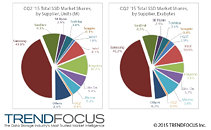Advantech Unveils Hailo-8 Powered AI Acceleration Modules for High-Efficiency Vision AI Applications
Advantech, a leading provider of AIoT platforms and services, proudly unveils its latest AI acceleration modules: the EAI-1200 and EAI-3300, powered by Hailo-8 AI processors. These modules deliver AI performance of up to 52 TOPS while achieving more than 12 times the power efficiency of comparable AI modules and GPU cards. Designed in standard M.2 and PCIe form factors, the EAI-1200 and EAI-3300 can be seamlessly integrated with diverse x86 and Arm-based platforms, enabling quick upgrades of existing systems and boards to incorporate AI capabilities. With these AI acceleration modules, developers can run inference efficiently on the Hailo-8 NPU while handling application processing primarily on the CPU, optimizing resource allocation. The modules are paired with user-friendly software toolkits, including the Edge AI SDK for seamless integration with HailoRT, the Dataflow Compiler for converting existing models, and TAPPAS, which offers pre-trained application examples. These features accelerate the development of edge-based vision AI applications.
EAI-1200 M.2 AI Module: Accelerating Development for Vision AI Security
The EAI-1200 is an M.2 AI module powered by a single Hailo-8 VPU, delivering up to 26 TOPS of computing performance while consuming approximately 5 watts of power. An optional heatsink supports operation in temperatures ranging from -40 to 65°C, ensuring easy integration. This cost-effective module is especially designed to bundle with Advantech's systems and boards, such as the ARK-1221L, AIR-150, and AFE-R770, enhancing AI applications including baggage screening, workforce safety, and autonomous mobile robots (AMR).
EAI-1200 M.2 AI Module: Accelerating Development for Vision AI Security
The EAI-1200 is an M.2 AI module powered by a single Hailo-8 VPU, delivering up to 26 TOPS of computing performance while consuming approximately 5 watts of power. An optional heatsink supports operation in temperatures ranging from -40 to 65°C, ensuring easy integration. This cost-effective module is especially designed to bundle with Advantech's systems and boards, such as the ARK-1221L, AIR-150, and AFE-R770, enhancing AI applications including baggage screening, workforce safety, and autonomous mobile robots (AMR).


































